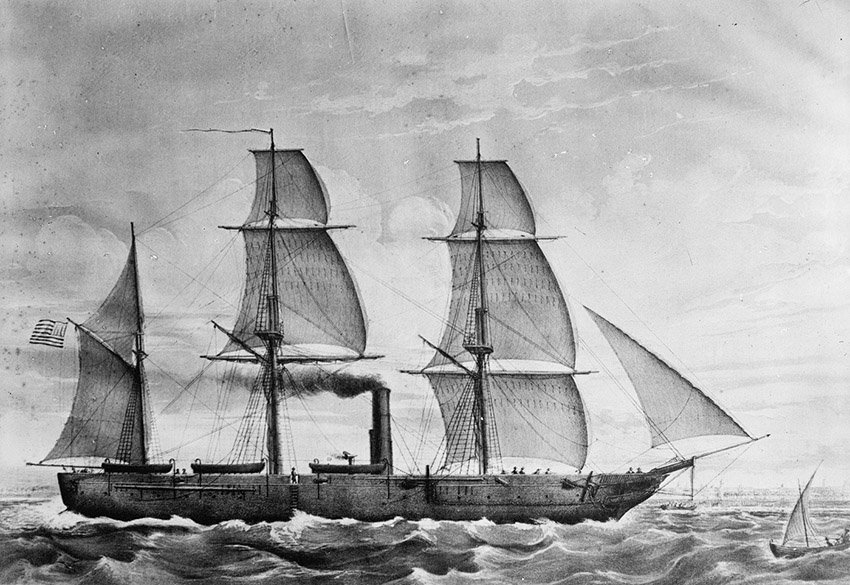Phil Kohn can be reached at USCW160@yahoo.com.
In the Caribbean Sea, the Confederate cruiser CSS Alabama, commanded by Capt. Raphael Semmes, on November 17, 1862, sails into the harbor of Fort-Royal (later Fort-de-France), Martinique, in the French West Indies. Following reports that Alabama might be there, the Federal frigate USS San Jacinto arrives the next morning. As Alabama is entitled to sanctuary in the neutral port, San Jacinto soon withdraws to international waters three miles outside the mouth of the harbor to lie in wait for the departure of the Southern vessel so it can legally attack it.
On November 18, the Federal Army of the Potomac arrives at Falmouth, Virginia, across the Rappahannock River from Fredericksburg. Over the next two days Union and Confederate forces take up positions around Fredericksburg. As the bridges across the Rappahannock River had previously been destroyed, Maj. Gen. Burnside requests pontoons to be delivered so his engineers can build six pontoon bridges for the planned crossing.
In Mississippi, on November 19, Maj. Gen. Ulysses S. Grant launches a reconnaissance force to determine the strength of Confederate troops defending Vicksburg. In the Caribbean, the night of November 19 is very dark and rainy. CSS Alabama sails out of Martinique’s Fort-Royal harbor and into the open sea. It is unseen by USS San Jacinto, waiting to attack the Southern ship once it departs French waters. San Jacinto remains on post, trying to determine if Alabama has left or is hiding in a secluded inlet of Fort-de-France Bay.
Gen. Robert E. Lee arrives in Fredericksburg, Virginia, on November 20 and begins organizing his defenses against the impending Federal assault. On the same day, Lt. Gen. Stonewall Jackson, anticipating a summons from Gen. Lee, begins moving his Second Corps of the Army of Northern Virginia out of Winchester, Virginia, and heads towards Fredericksburg, roughly 80 miles away.
Maj. Gen. Ambrose Burnside on November 21 sends a demand for surrender to Montgomery Slaughter, the mayor of Fredericksburg. Upon rejection of the proposal, Slaughter is told the town will be bombarded and is advised to evacuate women, children, the sick and the infirm from the city. In Richmond, Jefferson Davis appoints Virginia lawyer James A. Seddon as the new Confederate Secretary of War on November 21. Off Martinique, the Federal frigate USS San Jacinto, having determined that the CSS Alabama has indeed departed the island, sets sail in search of the Confederate raider.
Union Maj. Gen. Edwin Sumner on November 22 walks back Maj. Gen. Burnside’s surrender demand of the previous day. Sumner promises Fredericksburg mayor Montgomery Slaughter that in exchange of a promise of no hostile demonstrations by residents, he will not fire his artillery upon the city.
Federal naval forces capture Jacksonville, North Carolina, on November 23. The town is on the Atlantic coast, roughly midway between New Bern and Wilmington. At Fredericksburg, Lt. Gen. James Longstreet’s First Corps of the Army of Northern Virginia arrives from Culpeper. It is deployed to the west of town on a ridge known as Marye’s Heights.
On November 24, Braxton Bragg’s Confederates arrive in Murfreesboro, Tennessee, from Chattanooga. Bragg reorganizes his 45,000 troops and dubs them “The Army of Tennessee.” On the same day, Gen. Joseph Johnston returns to active duty after being wounded at Seven Pines, Virginia, in May. His assignment: to command the Western Theater (Alabama, Mississippi, Tennessee and parts of North Carolina, Georgia and Louisiana), supervising Bragg and Pemberton (who is in Vicksburg).
The first of the pontoons that had been requisitioned by Maj. Gen. Burnside arrive at Falmouth, Virginia, on November 25 but there are only enough for building one bridge. Five additional bridges are needed. The required remainder of pontoons, as these first had been, are delayed in arriving.
President Lincoln on November 26 leaves Washington, D.C., to meet with Maj. Gen. Burnside at Belle Plain, in northern Virginia.
Lincoln and Burnside meet on November 27 to discuss strategy for the upcoming battle, but don’t see eye-to-eye. Burnside’s idea is to directly assault Fredericksburg, where most of Lee’s Confederates are concentrated. Lincoln’s suggestion is to position troops at Falmouth, at a location south of the Rappahannock and at the Pamunkey River and then launch a three-pronged attack. Burnside decides to go with his own plan rather than the president’s.
Some 5,000 Federals under Brig. Gen. James Blunt on November 28 engage 8,000 Confederates led by Brig. Gen. John Marmaduke at Cane Hill, Arkansas, and force the Southerners to retreat over 40 miles southward toward the Arkansas River. Union casualties number around 40, while Confederate numbers are more than ten times that: 435.
Stonewall Jackson’s 2nd Corps of the Army of Northern Virginia arrives at Fredericksburg on November 29 after forced marches of up to 20 miles per day. Jackson deploys his men along the Rappahannock River south of town to prevent a Union crossing there. In the Far West, Maj. Gen. John B. Magruder assumes command of the Confederate Department of Texas, New Mexico and Arizona.
The remaining pontoons for the other five bridges that Maj. Gen. Burnside wishes to build for his assault finally arrive at Falmouth on November 30. However, he has lost all elements of surprise as the Confederates are already digging into strong defensive positions. In the Caribbean, the Federal cruiser USS Vanderbilt, armed with 15 heavy guns, joins USS San Jacinto in the hunt for the Confederate cruiser CSS Alabama.
In Washington, D.C., President Lincoln on December 1 delivers his State of the Union message to Congress. Among his points, he notes that commerce is in relatively good condition and that Federal receipts exceed expenditures. He also proposes, among other things, that Congress provide for colonization outside the U.S. of free persons of color with their consent.
On December 3, some 20,000 Union soldiers under Brig. Gen. Charles Hovey — part of Maj. Gen. Ulysses S. Grant’s plan to take Vicksburg, Mississippi — seize Grenada, Mississippi, a railhead. Unable to move the rolling stock, retreating Confederates destroy 15 locomotives and over 100 railroad cars.
A small Confederate raid is made on Prestonburg, in southeastern Kentucky, on December 4. Maj. Gen. Nathaniel Banks sets sail from New York with a Federal expeditionary force of 20,000 troops, headed for New Orleans, Louisiana, where he will take command from Maj. Gen. Benjamin Butler. In the Shenandoah Valley of Virginia, Winchester — with Stonewall Jackson’s troops having departed for Fredericksburg — falls into Federal hands. Confederate Gen. Joseph Johnston assumes overall command of the Western Theater. (In general, the Western Theater encompasses military operations in Alabama, Florida, Georgia, Kentucky, Mississippi, North Carolina, South Carolina, Tennessee, and Louisiana east of the Mississippi River.)
In northern Mississippi, on December 5, Confederates repulse a Union cavalry attack at Coffeeville, near Grenada.
President Lincoln on December 6, after reviewing their cases, orders 38 leaders of the Indian uprisings in the Northwest during August and September to be executed.








